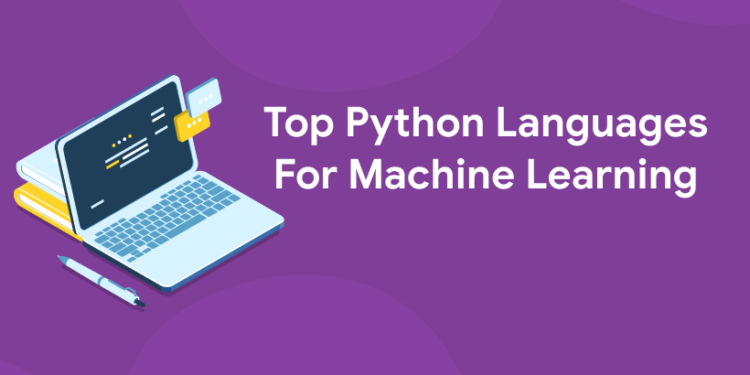Table of Contents
When you start learning machine learning, you’ll find that there are many different programming languages to choose from. Each language has its own strengths and weaknesses, and not all of them will be the best choice for your particular needs or project type. In this article, we’ll take a look at the top programming languages for machine learning. You may be surprised by some of the results, but you’ll find that there’s a language perfect for every possible situation when it comes to machine learning projects!
Get a free demo for our certificate program in data science and Machine learning
1) Python
The python language was developed by Guido van Rossum in 1989 and has continued to be popular among data scientists and statisticians. Its simplicity and ease of use, plus its large following of users, has made it one of the most used languages for machine learning projects. Although Python isn’t necessarily better or worse than other programming languages when it comes to machine learning capabilities, there are several reasons why python is so widely used. For starters, it has a great set of libraries specifically designed for machine learning which makes building models easy to do even if you aren’t an expert programmer.
Learn data science and machine learning course
2) Java
1: Which of the following data structures allows elements to be added and removed in a Last-In, First-Out (LIFO) order?
For a long time, Java was a favorite language among programmers working with machine learning. The speed and complexity of coding can be challenging at times, but it’s widely used in commercial applications. Some of these include Apple’s Siri and Amazon’s Kindle e-reader software. C++: It isn’t used as often as others on our list, but C++ is still a powerful choice for machine learning developers who want to code quickly. Facebook developed its artificial intelligence platform with C++, which allows companies to easily create new features that can adapt to their customers. However, you might need an experienced programmer to help you get started since it requires knowledge of how computers work at a lower level than most other languages.
3) R
R has a reputation as being a language that’s good for data science and machine learning—and it’s true. It’s a powerful tool, but as such, is one of more complex to learn and use in terms of its syntax. That said, some argue that R can do anything from any programming language out there. It also has a large following on Stack Overflow. If you do want to dip your toes into R first before moving onto Python (or vice versa), consider starting with data analysis software like Microsoft R Server or Revolution Analytics. Both are built on top of open-source R packages and provide an intuitive user interface to get you started right away without knowing too much about how it works under-the-hood
Get a free demo for our certificate program in data science and Machine learning
4) Scala
Scala is a multi-paradigm programming language that runs on JVM. It supports object-oriented, functional, and imperative programming styles. Scala is more concise than Java, making it one of the favorite tools of programmers. Its interoperability with Java has made it popular in an enterprise environment. Scala can be used to develop complex applications thanks to its support for advanced programming languages such as lambda calculus. It comes with an extensive library of data structures, collections frameworks, and algorithms. Developers often use Scala’s collection classes to represent mathematical expressions involving symbolic data types like fractions and matrices. The language’s expressive power makes it suitable for many high-level applications such as graphics processing units (GPUs) or reactive user interfaces. Go: Google developed Go as an alternative to C++ designed specifically for building large software systems while being fast enough to be used on small projects as well. While its primary use cases are distributed systems and microservices, Google uses Go at its server infrastructure layer across thousands of machines where latency matters more than performance.
5) Perl
Perl is an excellent choice for machine learning and data analysis because it’s fast and easy to use. It is especially known as a powerful tool for text processing, which is ideal when dealing with large amounts of unstructured data. With Perl, you have easy access to scientific libraries like SciPy, Numpy, and Pandas. One drawback is that it doesn’t have any data visualization libraries, so if that’s important to you look elsewhere. It does offer MATLAB compatibility, however.
6) Julia
Julia was developed by MIT’s Erik Weingarten and Viral Shah in 2011. It is a high-level programming language used for scientific, mathematical, and data analytics tasks. Julia focuses on readability, efficiency, and speed of development. It also allows you to use multiple paradigms such as imperative programming, functional programming, procedural programming, and object-oriented programming all at once! In May 2017, it was announced that Julia will be included in the Linux distribution Fedora 27. Moreover, Amazon Web Services also supports using Julia for machine learning applications. This makes it one of the top languages for machine learning.
Nothing comes close to Java when talking about popularity among software developers worldwide. For example, several big firms like Oracle have recently bought Java programs from BitVoicer—allowing them to grow their industry tenfold (or more). Currently used primarily in business operations involving significant numbers or amounts of data or transactions, Java has helped many organizations streamline day-to-day business operations and boost profits tremendously. For example, if Apple needed several different mobile apps made simultaneously—Java would be able to help them do so much faster than any other language could manage—and more easily too! This makes Java perfect when thinking about how best to learn programming languages.
7) C++
C++ is commonly used in high-performance computing and large-scale data analysis environments. It’s highly efficient in terms of memory usage, which makes it a popular language choice with businesses that need to run massive analytics jobs. C++ is also a great option if you’re looking to create your own machine learning library. Plus, since it’s C-based, many developers with experience coding in other languages can easily transfer their skills over to C++. However, a lack of general familiarity with object-oriented programming (OOP) may make things challenging for some beginners. C++ requires an intricate understanding of OOP concepts, as well as an ability to use complex algorithms effectively. If you’re interested in developing your own machine learning model from scratch or creating your own custom machine learning package from one already available on GitHub, you might want to check out how deep neural networks operate. This will give you a better idea of how easy or difficult it would be to code something similar yourself in C++.
8) PHP
PHP is one of those languages that I’ve used mainly as a server-side language, but it’s also been implemented as a client-side scripting language. It’s often installed with web hosting packages and commonly used in web development to create dynamic websites and applications. This can be particularly handy when developing locally, where you may not have access to all of your favorite tools like Anaconda or Rodeo. In addition to PHP, you can also use JavaScript (or JQuery) for front-end development using technologies like NodeJS. As far as machine learning is concerned, PHP has great implementations of both linear algebra libraries and scikit-learn.
Learn data science and machine learning course
9) JavaScript
The good ol’ standby. Matlab is a programming language and a software environment that makes it easy to analyze data, develop algorithms, and create models. Although it’s proprietary software (owned by MathWorks), many universities offer computer science students access to Matlab through their student license agreements. MATLAB is ideal for people who are new to machine learning; if you want to gain hands-on experience with a system you’re familiar with, Matlab is an excellent choice—and it’s also a great option if you want to transition into the industry. R: Fast gaining in popularity, R is known as GNU S, which stands for statistics. It’s open-source and free, though users will have to make some effort to learn how to use it.
10) Matlab
The most widely used language in science and engineering, Matlab is one of the top three languages taught in university-level computer science courses. Designed to perform matrix operations and support complex algorithms, Matlab is useful if you’re doing a lot of scientific computing. Matlab has a free version as well as commercial versions that offer additional features. The downside to Matlab is that it’s designed specifically with numerical computing in mind. So while it’s great at what it does, other languages might be better at things like processing text or images. For example, if you need to do speech recognition or natural language processing, you’d be much better off using Python or Java than Matlab because they were designed with these tasks in mind. If you are interested to learn new coding skills, the Entri app will help you to acquire them very easily. Entri app is following a structural study plan so that the students can learn very easily. If you don’t have a coding background, it won’t be any problem. You can download Entri app from the google play store and enroll in your favorite course.











